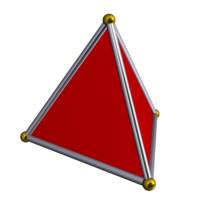Tetrahedron
| Tetrahedron | |
|---|---|
 | |
| Rank | 3 |
| Type | Regular |
| Notation | |
| Bowers style acronym | Tet |
| Coxeter diagram | x3o3o ( |
| Schläfli symbol | {3,3} |
| Tapertopic notation | 12 |
| Conway notation | T |
| Stewart notation | Y3 |
| Elements | |
| Faces | 4 triangles |
| Edges | 6 |
| Vertices | 4 |
| Vertex figure | Equilateral triangle, edge length 1  |
| Petrie polygons | 3 skew squares |
| Measures (edge length 1) | |
| Circumradius | |
| Edge radius | |
| Inradius | |
| Volume | |
| Dihedral angle | |
| Heights | Point atop trig: |
| Dyad atop perp dyad: | |
| Central density | 1 |
| Number of external pieces | 4 |
| Level of complexity | 1 |
| Related polytopes | |
| Army | Tet |
| Regiment | Tet |
| Dual | Tetrahedron |
| Petrie dual | Petrial tetrahedron |
| κ ? | Petrial cube |
| Conjugate | None |
| Abstract & topological properties | |
| Flag count | 24 |
| Euler characteristic | 2 |
| Surface | Sphere |
| Orientable | Yes |
| Genus | 0 |
| Properties | |
| Symmetry | A3, order 24 |
| Flag orbits | 1 |
| Convex | Yes |
| Net count | 2 |
| Nature | Tame |
The tetrahedron or tet, also sometimes called the 3-simplex, is the simplest possible non-degenerate polyhedron. The full symmetry version has 4 equilateral triangles as faces, joining 3 to a vertex, and is one of the 5 Platonic solids. It is the 3-dimensional simplex.
It is the uniform digonal antiprism and regular-faced triangular pyramid. Both of these forms are convex segmentohedra.
A regular tetrahedron of edge length √2 can be inscribed in the unit cube. In fact the tetrahedron is the alternated cube, which makes it the 3D demihypercube. The next larger simplex that can be inscribed in a hypercube is the octaexon.
The tetrahedron occurs as cells of three of the six convex regular polychora, namely the pentachoron, hexadecachoron, and hexacosichoron, as well as one of the star regular polychora, the grand hexacosichoron.
Vertex coordinates[edit | edit source]
Coordinates for the vertices of a tetrahedron can be given by all even changes of sign of:
- .
These arise from the fact that a tetrahedron can be constructed as the alternation of the cube. Multiplying these coordinates by give integral coordinates.
Alternate coordinates can be derived from those of the triangle, by considering the tetrahedron as a triangular pyramid:
- ,
- ,
- .
These are more complicated, but generalize to simplexes of any dimension.
Simpler coordinates can be given in four dimensions, as all permutations of:
- .
Multiplying these coordinates by gives another set of integral coordinates.
Representations[edit | edit source]
A regular tetrahedron can be represented by the following Coxeter diagrams:
- x3o3o (




 ) (full symmetry)
) (full symmetry) - s2s4o (




 ) (digonal antiprism, is generally a tetragonal disphenoid)
) (digonal antiprism, is generally a tetragonal disphenoid) - s2s2s (




 ) (alternated cuboid, generally a rhombic disphenoid)
) (alternated cuboid, generally a rhombic disphenoid) - ox3oo&#x (A2 axial, generally a triangular pyramid)
- xo ox&#x (A1×A1 axial, generally a digonal disphenoid)
- oox&#x (A1 only, generally a sphenoid)
- oooo&#x (no symmetry, fully irregular tetrahedron)
In vertex figures[edit | edit source]
| Name | Picture | Schläfli symbol | Edge length |
|---|---|---|---|
| Pentachoron |  |
{3,3,3} | |
| Tesseract |  |
{4,3,3} | |
| Hecatonicosachoron |  |
{5,3,3} | |
| Great grand stellated hecatonicosachoron |  |
{5/2,3,3} | |
| Hexagonal tiling honeycomb |  |
{6,3,3} |
Related polyhedra[edit | edit source]
Two tetrahedra can be attached at a common face to form a triangular tegum, one of the Johnson solids.
A tetrahedron can also be elongated by attaching a triangular prism to one of the faces, forming the elongated triangular pyramid.
A number of uniform polyhedron compounds are composed of tetrahedra:
- Stella octangula (2)
- Chiricosahedron (5)
- Icosicosahedron (10)
- Snubahedron (6)
- Small snubahedron (6, with rotational freedom)
- Disnubahedron (12, with rotational freedom)
- An infinite number of prismatic compounds that are antiprisms of compounds of digons (where the digons degenerate to edges).
Other kinds of tetrahedra[edit | edit source]
Besides the regular tetrahedron, there are a number of other polyhedra containing four triangular faces. Tetrahedra are generally classified by symmetry. Some of these classes of tetrahedra include:
- Triangular pyramid - one equilateral triangle (base) and three identical isosceles triangles
- Tetragonal disphenoid - four identical isosceles triangles
- Digonal disphenoid - Two pairs of identical isosceles triangles
- Rhombic disphenoid - Four identical scalene triangles
- Phyllic disphenoid - Two pairs of identical scalene triangles
- Sphenoid - Only a single symmetry axis
- Irregular tetrahedron - No symmetry axes at all
External links[edit | edit source]
- Bowers, Jonathan. "Polyhedron Category 1: Regulars" (#1).
- Klitzing, Richard. "tet".
- Quickfur. "The Tetrahedron".
- Wikipedia contributors. "Tetrahedron".
- McCooey, David. "Tetrahedron"
- Hi.gher.Space Wiki Contributors. "Tetrahedron".
- Hartley, Michael. "{3,3}*24".
- Wedd, N. The tetrahedron
























